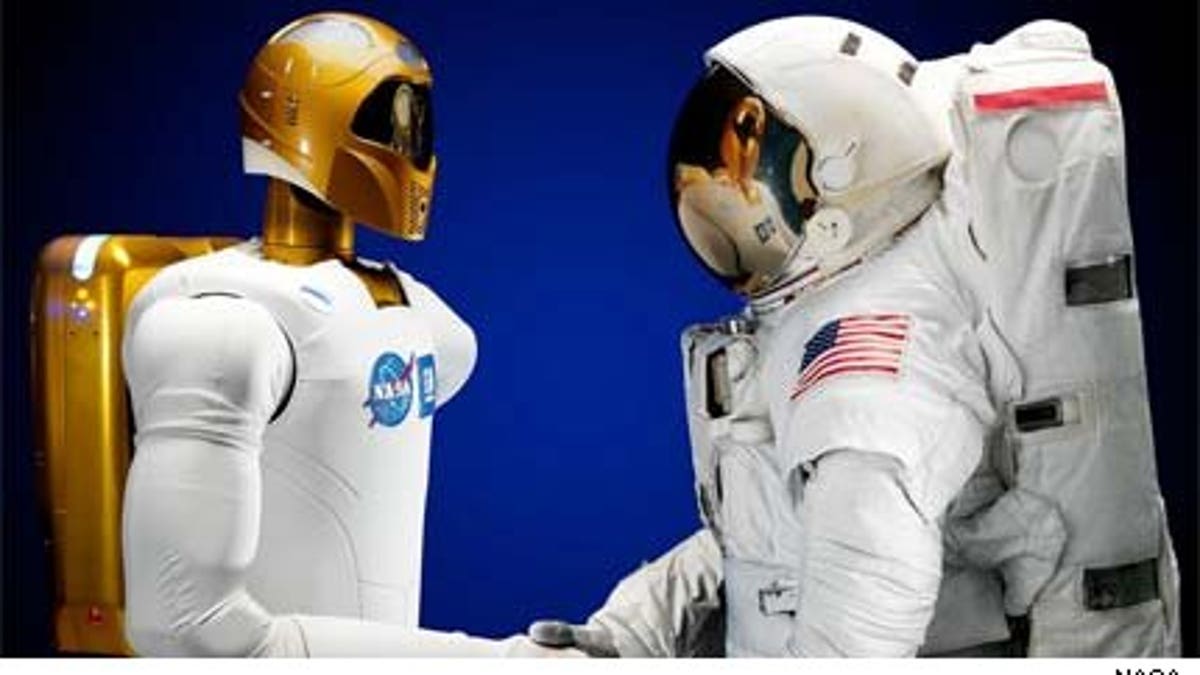
They require no food, can last for decades, willingly perform mundane tasks, and can walk in space without a spacesuit. And they’re mostly expendable -- if you overlook the cost.
Humanoid robots could make deep space exploration more feasible. As NASA prepares for Endeavour's last mission, and the final shuttle flight ever by Atlantis in June, space experts are starting to wonder if NASA should rethink its mission. Should future crafts be flown by autonomous bots we control from Earth?
The most advanced humanoid ever created is already in space aboard the International Space Station, after all -- just waiting for instructions and the green "go" light from NASA.
Launched on the Discovery space shuttle in February, Robonaut 2 (or R2) is still in parts; only his torso is in space, explained Marty Linn, the GM project manager for R2. (A future mission will bring the rest of his body.)
“It currently takes hours for an astronaut to prepare for a spacewalk. But it's conceivable that a robot could go outside the capsule at a moment's notice,” Linn told FoxNews.com. “We plan to develop the technology to the point that the next R2 will be able to work outside the capsule,” he said.
Behind the scenes at the robot lab
FoxNews.com recently toured the closed development lab at the GM technical center in Warren, Michigan. In a closed test area there, engineers were busy building new artificial intelligence routines and preparing R2 for future missions.
One potential appendage, connected to a computer, could grasp objects and move fingers freely. When you push against one finger, the robot recognizes the resistance and stops moving. The shiny metal arm looked like something out of a Terminator movie. (By sheer coincidence, Skynet -- a fictional robotic intelligence in the movie series -- became self-aware on April 19, 2011.)
R2 has incredible dexterity. The bot can move its hands in 12 directions, twist arms and wrists in seven ways, and uses 54 servo motors. Touch sensitive cells embedded into each hand can sense weight and pressure. GM designed a unique torsional spring to control fine motor movements.
The bot has a human-like head with a dark visor -- it’s partly to help astronauts relate to the humanoid as another team member but also has a practical purpose: a technician can control the robot using a video relay: Each movement the human controller makes is replicated by the robot.
Linn explained that the next step is to train R2 to perform mundane tasks, such as sterilizing hand rails aboard the space station -- a chore that astronauts tend to hate doing.
Humanoids in space?
The advantages to using humanoids are clear, but NASA argues that humanoids will always play second fiddle to real humans in space and only enhance our own exploratory missions.
“Data from Star Trek was never out by himself exploring the universe,” Nic Radford, Robonaut deputy project manager, told FoxNews.com. “Even Hollywood has recognized the fact that having the human element along with the most advanced humanoid makes sense. We’ll never be able to replace the human experience with a computer. Still, humans can more effectively explore with advanced tools like robots.”
Larry Mathias, a research scientist at NASA’s Joint Propulsion Lab (JPL), told FoxNews.com that it will be a very long time before humanoids are so self-aware that they can explore space without any human intervention. He said machines are still not capable of making important scientific decisions.
There is also a technical limitation. Before we send a bot on its own to look for extraterrestrial life or discover new planets, we will need better advancements in sensor technology and batteries.
“Humanoid bots will need a better sense of touch, vision, and the ability to combine the two in order to manipulate things in hand like using a tool, turning a bolt, or operating a switch,” Mathias said. “Additionally, humanoid bots take a lot of electricity and run out of power in short amounts of time. They will need more efficient motors, computers, and greater power density for energy storage.”
Radford noted that humanoids will always lack one key differentiator for space exploration: sheer imagination. Bots only do what we have programmed them to do, Linn said.
And for now that is really focused on the tasks that humans have no interest in doing.
John Brandon is a science and technology reporter. Follow him on Twitter @jmbrandonbb.
